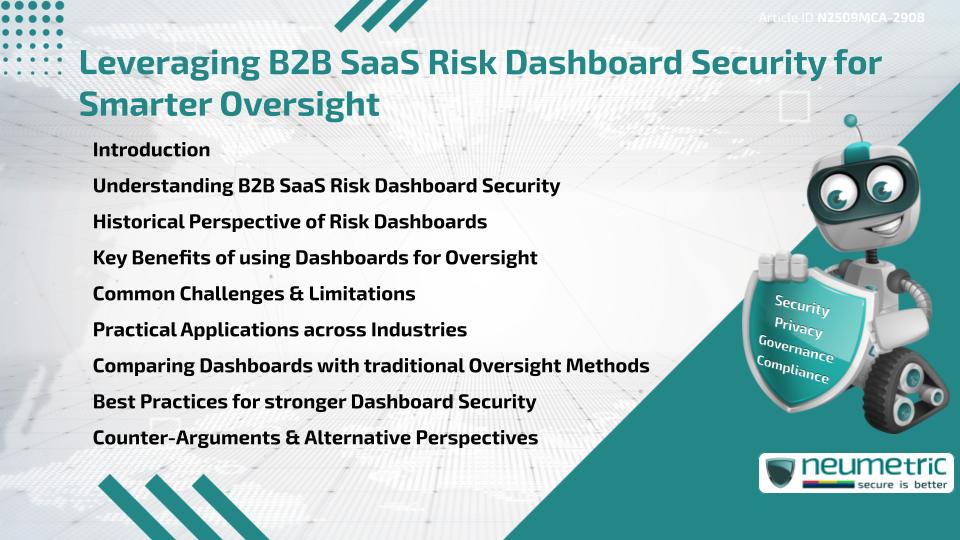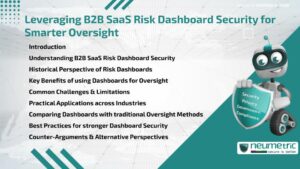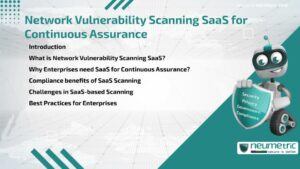Table of Contents
ToggleIntroduction
In the digital economy, organisations are increasingly relying on B2B SaaS Risk Dashboard Security to gain better visibility into Threats, Vulnerabilities & Compliance obligations. These dashboards provide centralised oversight, enabling businesses to detect anomalies quickly, streamline reporting & ensure that Risk Management strategies align with Regulatory Frameworks. While traditional oversight often lacked agility, modern dashboards combine real-time monitoring with actionable insights, making them indispensable tools for Security & Governance.
By understanding the origins, benefits, challenges & applications of these dashboards, Organisations can make informed decisions about their role in Risk Management. This article explores how B2B SaaS Risk Dashboard Security contributes to smarter oversight, while also acknowledging limitations & counter-arguments to provide a balanced view.
Understanding B2B SaaS Risk Dashboard Security
A Risk dashboard in the context of Software-as-a-Service [SaaS] is a platform that consolidates data from multiple sources & presents it in a clear & actionable manner. With B2B SaaS Risk Dashboard Security, businesses gain a single pane of glass to monitor their Security Posture, Compliance status & Potential Threats.
Think of it as a car’s dashboard-drivers cannot directly see the condition of every engine part, but they rely on indicators like speed, fuel level & warnings to make safe decisions. Similarly, Risk dashboards highlight key security metrics, allowing executives & analysts to respond quickly when something seems off.
Historical Perspective of Risk Dashboards
Risk dashboards have evolved from static spreadsheets & manual reporting methods into dynamic, automated platforms. In the early 2000s, businesses primarily relied on quarterly reports to track Risks, which often resulted in delayed responses. As Cyber Threats grew more sophisticated, the need for continuous oversight led to the development of automated dashboards that could present real-time updates.
The shift from reactive reporting to proactive monitoring was a turning point. By the 2010s, dashboards had become Standard for industries like Finance & Healthcare, where Compliance & Security Risks were critical. Today, with B2B SaaS Risk Dashboard Security, organisations across all sectors can access advanced tools without heavy infrastructure investments.
Key Benefits of using Dashboards for Oversight
Dashboards provide several tangible advantages for smarter oversight:
- Real-time monitoring of Vulnerabilities, Threats & Incidents.
- Centralised visibility across diverse business units.
- Regulatory Compliance support through automated reporting.
- Faster decision-making by highlighting high-priority Risks.
- Cost savings by reducing manual monitoring & reporting efforts.
This combination allows leaders to make better strategic choices while security teams focus on resolving the most pressing issues.
Common Challenges & Limitations
Despite their advantages, Risk dashboards are not without challenges. Over-reliance on dashboards can create a false sense of security if the data sources feeding them are incomplete or inaccurate. Additionally, some businesses face integration issues when trying to consolidate data from legacy systems.
Another limitation lies in the human element. Dashboards present information, but interpretation & action still depend on decision-makers. Without proper training, users may misinterpret signals or overlook critical warnings.
Practical Applications across Industries
The adoption of B2B SaaS Risk Dashboard Security is not confined to one industry. Financial institutions use Dashboards to ensure Compliance with Anti-fraud Regulations. Healthcare Organisations rely on them to safeguard Patient Data under HIPAA. Technology firms use Dashboards to protect Intellectual Property & monitor Vendor Risks.
By tailoring dashboards to their specific needs, industries can achieve oversight that is both comprehensive & adaptable.
Comparing Dashboards with traditional Oversight Methods
Traditional oversight relied heavily on manual reporting & fragmented tools. These methods were often slow, resource-intensive & prone to human error. In contrast, dashboards bring automation, visualisation & consistency to oversight.
An analogy can be made with navigation systems. Paper maps served their purpose, but GPS transformed travel by offering live updates & recalculations. Similarly, dashboards have revolutionised oversight by shifting from static reports to real-time, adaptive monitoring.
Best Practices for stronger Dashboard Security
To maximise the value of B2B SaaS Risk Dashboard Security, Organisations should follow Best Practices:
- Regularly validate & update data sources feeding the dashboard.
- Train staff to interpret dashboard outputs effectively.
- Establish Role-based Access Controls to prevent misuse.
- Continuously test dashboard integrations with other systems.
- Align dashboard metrics with organisational goals.
By following these practices, businesses can avoid common pitfalls & strengthen oversight.
Counter-Arguments & Alternative Perspectives
Not everyone agrees that Dashboards are the ultimate solution. Some critics argue that Dashboards can overwhelm users with too much information, leading to “alert fatigue”. Others point out that dashboards still depend on accurate data inputs, meaning that weaknesses in underlying systems can compromise their effectiveness.
Despite these concerns, the benefits often outweigh the drawbacks when dashboards are implemented thoughtfully & paired with proper Governance.
Takeaways
- B2B SaaS Risk Dashboard Security provides real-time visibility into Risks.
- Dashboards evolved from static reports to dynamic oversight tools.
- Benefits include faster Decisions, Compliance support & Cost Savings.
- Challenges include data quality, integration & training needs.
- Best Practices help maximise the effectiveness of Dashboards.
FAQ
What is B2B SaaS Risk Dashboard Security?
It is a software-based platform that consolidates Risk & Security data into a centralised dashboard for monitoring, analysis & oversight.
How does a Risk dashboard improve oversight?
It provides real-time visibility into security metrics, enabling faster & more informed decision-making compared to manual reporting.
Are dashboards suitable for Small Businesses?
Yes, many SaaS-based dashboards are scalable & affordable, making them accessible for small & medium-sized enterprises.
What industries benefit the most from these dashboards?
Industries such as Finance, Healthcare & Technology often benefit the most due to their high Compliance & Security requirements.
Can dashboards replace traditional audits?
No, Dashboards complement but do not replace Audits. They provide Continuous Monitoring, whereas Audits offer periodic Assessments.
What are the Risks of over-relying on dashboards?
Over-reliance can lead to a false sense of security if data inputs are flawed or if users misinterpret dashboard outputs.
How can businesses ensure dashboard effectiveness?
By maintaining data accuracy, training staff & aligning dashboards with organisational goals, businesses can ensure dashboards remain effective.
Need help for Security, Privacy, Governance & VAPT?
Neumetric provides organisations the necessary help to achieve their Cybersecurity, Compliance, Governance, Privacy, Certifications & Pentesting needs.
Organisations & Businesses, specifically those which provide SaaS & AI Solutions in the Fintech, BFSI & other regulated sectors, usually need a Cybersecurity Partner for meeting & maintaining the ongoing Security & Privacy needs & requirements of their Enterprise Clients & Privacy conscious Customers.
SOC 2, ISO 27001, ISO 42001, NIST, HIPAA, HECVAT, EU GDPR are some of the Frameworks that are served by Fusion – a SaaS, multimodular, multitenant, centralised, automated, Cybersecurity & Compliance Management system.
Neumetric also provides Expert Services for technical security which covers VAPT for Web Applications, APIs, iOS & Android Mobile Apps, Security Testing for AWS & other Cloud Environments & Cloud Infrastructure & other similar scopes.
Reach out to us by Email or filling out the Contact Form…





